The 'fast track' to Stracathro? - 18 Weeks
The 'fast track' to Stracathro? - 18 Weeks
The 'fast track' to Stracathro? - 18 Weeks
Create successful ePaper yourself
Turn your PDF publications into a flip-book with our unique Google optimized e-Paper software.
<strong>The</strong> ‘fast track’ <strong>to</strong> success?<br />
Dr Christina Beecroft<br />
Consultant Anaesthetist<br />
NHS Tayside
Background<br />
• First case September 2010<br />
• ‘On‐call’ for any problems<br />
• Initially EVERYONE <strong>to</strong>ld me about EVERY<br />
problem…….<br />
• Gradual acceptance from all staff with interest<br />
from other Grampian surgeons<br />
• By Spring 2011 all Grampian patients<br />
managed at <strong>Stracathro</strong> followed enhanced<br />
recovery pro<strong>to</strong>col
Pre‐op information (from PAC/CB)<br />
Change in attitude<br />
– Expect pain<br />
Major surgery<br />
Different <strong>to</strong> pre‐op pain and it will get better<br />
– Encourage patient <strong>to</strong> take control of their<br />
recovery<br />
Goals –out of bed day 0, no bed pans, aim for home<br />
day 2
Premedication on day of surgery<br />
• Gabapentin 300 mg<br />
• Paracetamol 1G orally (continue qds)<br />
• If first patient on list, oxycontin 10/20 mg<br />
orally<br />
• Unrestricted intake of water until a minimum<br />
of 2 hours before surgery (avoid prolonged<br />
fasting)
Anaesthesia<br />
• Low‐dose spinal anaesthesia* (2‐2.5 ml of 5 mg/ml<br />
levo‐bupivacaine) with no intrathecal opioid<br />
• Tranexamic acid 15 mg/kg slow IV bolus<br />
• Prophylactic anti‐emetics (triple therapy<br />
dex/ondansetron/droperidol)<br />
• Sedation as required –Midazolam +/‐ TCI Propofol<br />
*Lower dose spinal allows the block <strong>to</strong> regress more quickly, facilitates earlier<br />
mobilization and reduces the risk of post‐op hypotension and urinary retention.
Peri‐operative fluid balance<br />
• A low‐dose spinal combined with light sedation induces less<br />
peri‐operative hypotension<br />
• Post‐op fluids should only be prescribed if clinically indicated.<br />
If the patient is stable and drinking, the IV can be<br />
discontinued in recovery*<br />
• IV fluid boluses are then prescribed according <strong>to</strong> target blood<br />
pressure and urine output<br />
• Urinary catheterisation is only performed if clinically indicated<br />
*Patients requiring more active management of pos<strong>to</strong>perative fluid balance include:<br />
those with greater than anticipated blood loss, an unacceptably low blood<br />
pressure, previous MI/CVA/PTE, heart failure, diabetes, pre‐existing renal<br />
impairment (eGFR < 60 ml/min), anaemia, ACE inhibi<strong>to</strong>r, other significant medical<br />
co‐morbidities.
Local Anaesthetic<br />
• Dose of local anaesthetic used<br />
• 0.125% L‐bupivacaine instead of 0.2% ropivacaine<br />
• 150 ml infiltration intra‐operatively<br />
• Ambit pump 20 ml bolus 4 hourly<br />
• Cumulative dose over 24 hours therefore reduced
Levo‐Bupivacaine regime<br />
• Intra‐operative infiltration of 150 ml levobupivacaine<br />
1.25 mg/ml<br />
• TKR –intra‐articular catheter connected <strong>to</strong><br />
elas<strong>to</strong>meric pump containing 250 ml 0.125% L‐<br />
bupivacaine at a rate of 10 ml/hr.<br />
NB dose now 250 mg over 20 hours, <strong>to</strong>tal 437.5 mg<br />
(from 312.5 mg)
Additional post‐op analgesia<br />
• Paracetamol 1G qds<br />
• Regular NSAID if not contraindicated medically/surgically<br />
for 48 hours only with PPI cover (omeprazole 20 mg od)<br />
• Oxycontin as per NHST pro<strong>to</strong>col (10 mg bd THR, 20 mg bd TKR)<br />
• Oramorph 10 mg hourly for breakthrough pain<br />
*Morphine sulphate up <strong>to</strong> 10 mg IV and consider morphine<br />
PCA 1 mg bolus 5 min lock‐out in patients with poor<br />
response <strong>to</strong> oral analgesia<br />
• Gabapentin 300 mg on night of surgery<br />
• Consider zopiclone 3.75 mg nocte for 2 post‐op nights
Progress<br />
• Driven by nursing staff<br />
– Intrathecal morphine<br />
– Urinary catheter audit<br />
– Mobilisation audit<br />
– ‘Joint school’<br />
– Carbohydrate loading
Colleagues……<br />
• ‘What are we trying <strong>to</strong> achieve? Our patient’s<br />
already go home on day 3 which is better than<br />
Ninewells, what more do you want’!<br />
• Doing ‘bits’ of the pro<strong>to</strong>col<br />
– Adding gabapentin<br />
– Lower dose spinal but still with ITM<br />
– “Skinny” (dia)morphine<br />
– Enhanced recovery patients take priority which<br />
‘slows’ traditional patient’s mobilisation<br />
• ‘Quality not quantity’
“Enhanced recovery should improve outcome,<br />
shorten hospital stay and thus reduce the<br />
overall cost of care: a win‐win‐win scenario”<br />
Professor Monty Mythen, National Clinical Lead, Department of Health<br />
Enhanced Recovery Partnership<br />
Bulletin of the RCoA Number 69, September 2011



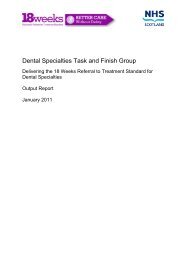
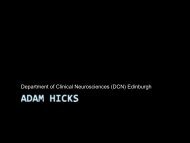
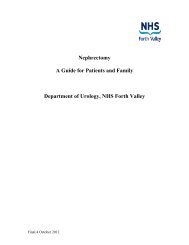
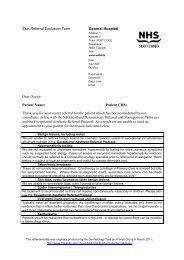
![Dr Matthew Checketts, NHS Tayside [PDF - 6Mb] - 18 Weeks](https://img.yumpu.com/49027155/1/190x143/dr-matthew-checketts-nhs-tayside-pdf-6mb-18-weeks.jpg?quality=85)
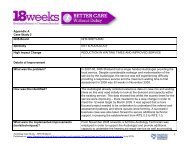
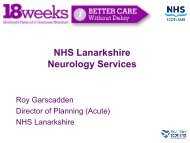
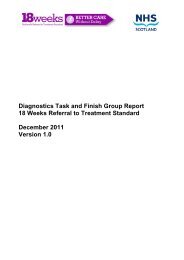

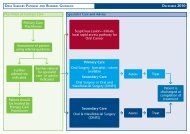


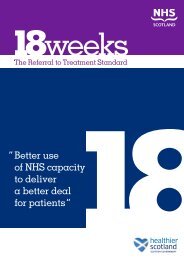
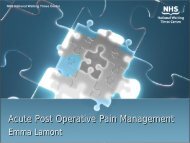
![Mark Sindall, NHS Dumfries and Galloway [PDF - 227Kb] - 18 Weeks](https://img.yumpu.com/30080335/1/190x143/mark-sindall-nhs-dumfries-and-galloway-pdf-227kb-18-weeks.jpg?quality=85)